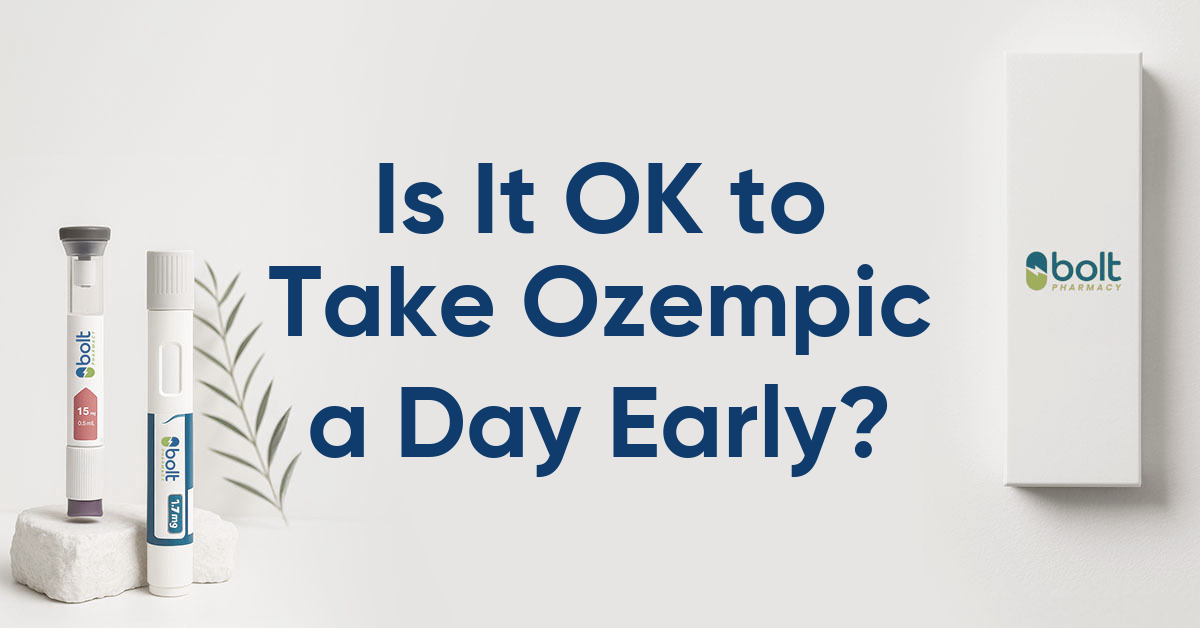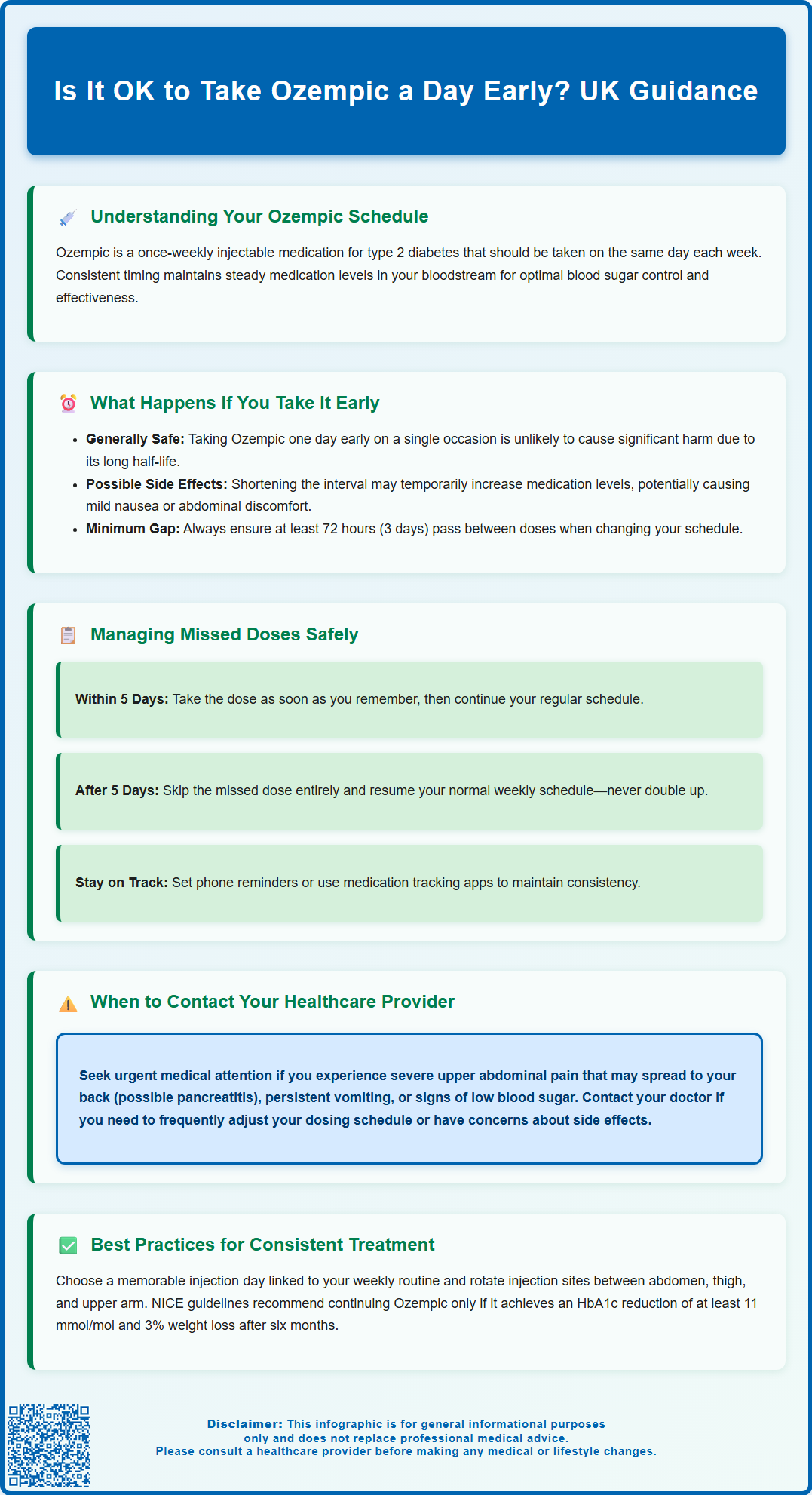Wegovy®
Similar to Ozempic, Wegovy also contains semaglutide but is licensed for weight management. It helps reduce hunger and supports meaningful, long-term fat loss.
- Supports clinically proven weight reduction
- Weekly injection, easy to use

Is it OK to take Ozempic a day early? Many people prescribed this once-weekly diabetes medication occasionally need to adjust their injection schedule. Ozempic (semaglutide) is a glucagon-like peptide-1 (GLP-1) receptor agonist used to manage type 2 diabetes in the UK. Taking your injection one day early is generally acceptable and unlikely to cause harm, as the medication's long half-life allows for minor timing adjustments. According to MHRA-approved guidance, you may change your injection day provided at least three days (72 hours) have elapsed between doses. Understanding when and how to safely adjust your dosing schedule helps maintain effective diabetes management whilst accommodating life's unpredictability.
Summary: Taking Ozempic one day early is generally acceptable and unlikely to cause significant harm, provided at least 72 hours have elapsed since your previous dose.
Ozempic (semaglutide) is a once-weekly injectable medication prescribed for type 2 diabetes management in the UK. It belongs to a class of medicines called glucagon-like peptide-1 (GLP-1) receptor agonists, which work by mimicking the action of the natural hormone GLP-1. This mechanism helps to stimulate insulin secretion when blood glucose levels are elevated, suppress glucagon release, slow gastric emptying, and reduce appetite—all contributing to improved glycaemic control.
The standard dosing schedule for Ozempic involves administering the injection once every seven days, ideally on the same day each week. This weekly regimen is designed to maintain steady therapeutic levels of semaglutide in your bloodstream, as the medication has a long half-life of approximately one week. Consistency in timing helps optimise the drug's effectiveness and may help manage side effects.
Patients typically begin with a lower starting dose (0.25 mg weekly for four weeks) to allow the body to adjust to the medication, reducing the likelihood of gastrointestinal side effects such as nausea or vomiting. The dose is then gradually increased according to your healthcare provider's guidance, with maintenance doses commonly ranging from 0.5 mg to 1 mg weekly, and in some cases up to 2 mg for those requiring additional glycaemic control.
Establishing a routine is crucial for treatment success. Many patients find it helpful to choose a specific day of the week that fits their schedule—such as every Sunday morning—and set reminders to ensure they don't forget their injection. The injection can be administered at any time of day, with or without meals, providing flexibility whilst maintaining the weekly interval. According to the MHRA-approved product information, you may change your weekly injection day if necessary, provided at least 3 days (72 hours) have elapsed between doses.
Taking your Ozempic injection one day early on a single occasion is generally considered acceptable and is unlikely to cause significant harm or adverse effects. The medication's long half-life and gradual mechanism of action mean that a minor adjustment of 24 hours does not typically result in dangerous medication levels or sudden changes in blood glucose control.
When you administer Ozempic a day earlier than scheduled, you are essentially shortening the interval between doses from seven days to six days. This slight reduction means there may be marginally higher levels of semaglutide in your system temporarily, which could potentially increase the likelihood of experiencing gastrointestinal side effects such as nausea, abdominal discomfort, or changes in bowel habits. These effects are usually mild and transient, particularly if you've been taking the medication for some time and your body has adjusted to it.
According to the MHRA-approved product information, you may change your weekly injection day provided at least 3 days (72 hours) have elapsed between doses. Taking your dose one day early meets this requirement, so you can establish this new day as your regular injection day moving forward if you wish. For example, if you normally inject on Saturdays but take your dose on Friday, you may continue with Fridays as your new regular injection day.
If you experience any unusual or severe symptoms after taking your injection early, particularly severe or persistent upper abdominal pain (which may radiate to your back), with or without vomiting, seek urgent medical help as this could indicate pancreatitis. You can report any suspected side effects to the MHRA Yellow Card Scheme at yellowcard.mhra.gov.uk or via the Yellow Card app.

Whilst taking Ozempic a day early once is generally not cause for alarm, there are specific circumstances where you should contact your healthcare provider for guidance. Understanding when to seek professional advice helps ensure your safety and maintains the effectiveness of your diabetes management plan.
You should contact your GP, diabetes specialist nurse, or prescribing clinician if you:
Experience severe or persistent side effects after taking your dose early, including severe nausea, repeated vomiting, severe abdominal pain, or signs of pancreatitis (intense upper abdominal pain radiating to the back) – seek urgent medical help for suspected pancreatitis
Have concerns about hypoglycaemia (low blood sugar), particularly if you're also taking other diabetes medications such as insulin or sulfonylureas
Need to frequently adjust your dosing schedule due to lifestyle or work commitments, as this may indicate the need for a more suitable treatment plan
Have kidney problems – while no dose adjustment is required in renal impairment, you should be monitored for dehydration if you experience gastrointestinal side effects
Have taken multiple doses too close together or are confused about when to take your next injection
Have pre-existing diabetic retinopathy, as rapid improvement in blood glucose control may temporarily worsen this condition
Additionally, if you're planning significant changes to your routine—such as international travel across multiple time zones—it's advisable to discuss dosing strategies with your healthcare team in advance. They can provide personalised guidance on how to adjust your injection schedule whilst maintaining therapeutic consistency.
Pregnancy planning requires special attention. Ozempic should be stopped at least 2 months before a planned pregnancy, and it is not recommended during pregnancy or breastfeeding. If you are pregnant, think you might be pregnant, or are planning to have a baby, seek immediate advice from your healthcare provider about alternative diabetes management strategies.
Understanding how to manage missed or delayed doses is just as important as knowing what to do if you take Ozempic early. The manufacturer's guidance, aligned with MHRA-approved prescribing information, provides clear instructions for these situations to help you maintain safe and effective treatment.
If you miss your scheduled Ozempic dose entirely, the appropriate action depends on how much time has passed:
If 5 days or less have passed since your missed dose: Administer the injection as soon as you remember, then resume on your originally scheduled day for your next dose.
If more than 5 days have passed since your missed dose: Skip the missed dose entirely and administer your next injection on your regularly scheduled day. Do not take a double dose to make up for the missed injection.
This guidance is based on maintaining appropriate medication levels whilst avoiding potential overdose or increased side effects from taking doses too close together. The five-day threshold represents a balance between maintaining therapeutic levels and preventing excessive accumulation of the medication in your system.
If you wish to change your regular weekly injection day, you may do so provided at least 3 days (72 hours) have elapsed between doses. This official guidance allows flexibility whilst ensuring adequate spacing between injections.
Practical strategies to avoid missed doses include setting multiple reminders on your phone, using a medication tracking app, storing your Ozempic pen in a visible location (whilst maintaining proper refrigeration for unused pens), or coordinating your injection day with a regular weekly activity. Unused pens should be stored in a refrigerator (2°C to 8°C); do not freeze. Once in use, pens may be kept at temperatures below 30°C for the period specified in the product information. Some patients find it helpful to keep a written log of their injections, noting the date, time, and injection site to maintain accountability and track their adherence pattern.
Consistency is fundamental to achieving optimal outcomes with Ozempic therapy. Regular, predictable dosing helps maintain stable medication levels in your bloodstream, which translates to more consistent blood glucose control, reduced side effects, and better long-term management of type 2 diabetes. Research supporting GLP-1 receptor agonist therapy demonstrates that adherence to the prescribed regimen is strongly associated with improved HbA1c reduction and sustained weight management benefits.
To maximise treatment effectiveness, consider implementing these evidence-based strategies:
Choose a convenient, memorable day for your weekly injection—many patients select the same day they attend religious services, do weekly shopping, or have other regular commitments
Prepare your injection supplies in advance, ensuring you have alcohol swabs, a sharps container, and your Ozempic pen readily accessible
Rotate injection sites systematically between your abdomen, thigh, or upper arm to reduce the risk of injection-site reactions and maintain consistent absorption
Monitor your blood glucose levels as recommended by your healthcare team, keeping a record to identify patterns and assess treatment effectiveness
Attend regular follow-up appointments with your GP or diabetes specialist nurse for ongoing assessment, dose adjustments, and HbA1c monitoring
According to NICE guidelines for type 2 diabetes management (NG28), GLP-1 receptor agonists like Ozempic should be continued only if they produce beneficial metabolic responses when used for type 2 diabetes, typically defined as a reduction in HbA1c of at least 11 mmol/mol (1.0%) and weight loss of at least 3% of initial body weight at six months. Consistent dosing is essential to achieving these therapeutic targets.
If you find yourself frequently needing to adjust your Ozempic schedule or struggling with adherence, this may indicate practical barriers that deserve attention. Discuss these challenges openly with your healthcare provider—they may be able to suggest solutions such as different injection techniques, strategies for managing side effects, or in some cases, alternative treatment options that better align with your lifestyle. Remember that successful diabetes management is a partnership between you and your healthcare team, and open communication about dosing challenges is an important part of that collaborative relationship.
If five days or less have passed since your missed dose, take it as soon as you remember and resume your regular schedule. If more than five days have passed, skip the missed dose and take your next injection on your regularly scheduled day.
Yes, you may change your weekly injection day provided at least three days (72 hours) have elapsed between doses. Once you select a new day, continue using that day for all subsequent injections.
Contact your healthcare provider if you experience severe or persistent side effects, need to frequently adjust your schedule, have concerns about low blood sugar, or experience severe upper abdominal pain that may indicate pancreatitis.
The health-related content published on this site is based on credible scientific sources and is periodically reviewed to ensure accuracy and relevance. Although we aim to reflect the most current medical knowledge, the material is meant for general education and awareness only.
The information on this site is not a substitute for professional medical advice. For any health concerns, please speak with a qualified medical professional. By using this information, you acknowledge responsibility for any decisions made and understand we are not liable for any consequences that may result.
Lorem ipsum dolor sit amet, consectetur adipiscing elit, sed do eiusmod tempor incididunt ut labore et dolore magna aliqua. Ut enim ad minim veniam, quis nostrud exercitation ullamco laboris nisi ut aliquip ex ea commodo consequat. Duis aute irure dolor in reprehenderit in voluptate velit esse cillum dolore eu fugiat nulla pariatur.
Block quote
Ordered list
Unordered list
Bold text
Emphasis
Superscript
Subscript